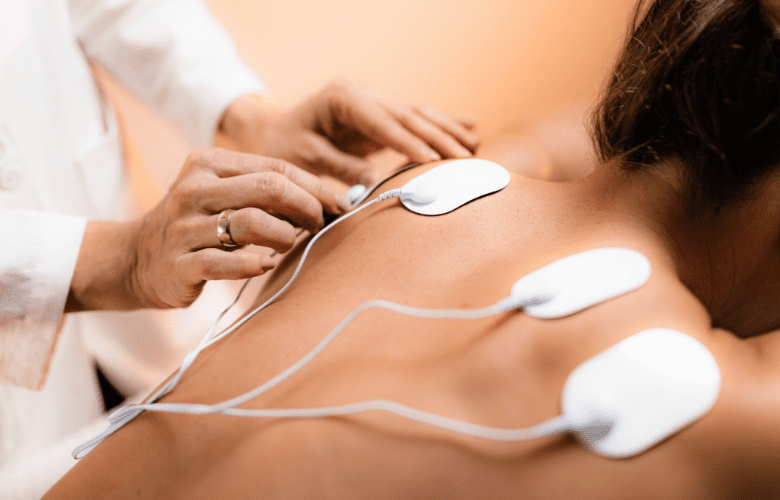5 PROVEN WAYS FREQUENCY SPECIFIC MICROCURRENT RELIEVES ANXIETY
Anxiety can feel like an uninvited guest that never leaves, constantly clouding your peace of mind. But what if there was a fresh way to tackle anxiety and take back control of your life? Well, frequency specific microcurrent (FSM) offers a promising solution. In this article, explore the incredible ways frequency specific microcurrent relieves anxiety. Discover how it could transform your life into a calmer, more focused you!
ANXIETY & THE BRAIN
Your brain is an amazing part of your body that controls everything you do, think, and feel. When it comes to anxiety, your brain can be both friend and foe. Anxiety is that feeling of worry or fear you get when you’re stressed or nervous about something.
One part of your brain that plays a big role in anxiety is called the amygdala. It’s a small, almond-shaped structure located deep within your brain’s temporal lobe. Its role in anxiety can be understood through the following points:
Fear Response
The amygdala is crucial in the body’s “fight or flight” response. It detects potential threats and triggers the release of stress hormones, preparing your body to react quickly. This is useful when you face real danger, like seeing a wild animal, because it helps you stay safe.
But sometimes, the amygdala can get too active even in seemingly safe situations. Take, for example, the unease you might feel when stepping into unfamiliar territory. The heightened state of vigilance can stir up feelings of apprehension or jitteriness without a clear cause. It’s the amygdala putting you on edge, even when there’s no tangible threat in sight.
Emotional Memory
Think of the amygdala as your emotional memory bank. It’s responsible for storing those intense feelings you experience during scary or anxiety-inducing situations. It captures the emotions you felt during those moments and etches them into your memory.
For example, if you had a scary experience like getting lost in a big store, the amygdala might help you remember how scared you felt. Later on, if you go back to that store or even think about it, your brain might remind you of that fear, making you feel anxious.
Connection with Other Brain Regions
The amygdala communicates with other areas of your brain to keep you safe and help you react to things around you. One part of the brain the amygdala talks to is the prefrontal cortex. This part helps you make decisions and think things through. It can sometimes tell the amygdala to calm down if it thinks you’re safe, helping to reduce anxiety.
However, when the amygdala and other parts of the brain don’t communicate well, you might feel anxious more often. That’s because your brain might not be able to tell the amygdala to relax when there’s no real danger.
Learning and Generalization
Sometimes, the amygdala can learn too much from one scary experience and start to think everything similar is a threat. For instance, you fell off the stairs. You might start to feel anxious about going up the stairs in general, even though most of the time it’s safe.
This is called generalization, and it can make you feel anxious about things that aren’t actually dangerous. The amygdala remembers the fear and makes you feel anxious in situations that remind you of your past bad experiences.
FREQUENCY SPECIFIC MICROCURRENT & HOW IT COMBATS ANXIETY: 5 WAYS
Frequency-specific microcurrent (FSM) is a special type of therapy that uses very low-level electrical currents to help your body feel better. During a session, special pads are placed on your skin. The machine sends the small currents through the pads to the targeted area. The currents are so gentle that you usually can’t even feel them.
When applied to treat anxiety, FSM works in the following ways:
1. Targeting specific frequencies
FSM harnesses the power of specific frequencies to pinpoint areas in the body and brain linked to anxiety. These gentle electrical currents, known as micro-amperage currents, closely resemble the natural currents produced within your body’s cells.
By fostering a natural and balanced response, FSM aims to harmonize with your body’s innate electrical signals, The treatment can be customized to fit your needs by adjusting the frequencies used based on your anxiety symptoms.
2. Balancing the autonomic nervous system
The autonomic nervous system consists of two main branches: the sympathetic nervous system (responsible for the “fight or flight” response) and the parasympathetic nervous system (responsible for the “rest and digest” response).
FSM can help regulate the activity of these branches, promoting a better balance between them. This balance is crucial for maintaining emotional stability and reducing anxiety.
3. Modulating Neurotransmitters
Anxiety is often linked to imbalances in neurotransmitters such as serotonin. Serotonin is known as the “feel-good” chemical because it helps regulate mood and anxiety. A 2008 study found that low levels of serotonin are associated with increased anxiety and depression.
FSM may help modulate serotonin levels by influencing the activity of neurons that produce and release serotonin. By promoting optimal serotonin levels, FSM can help alleviate anxiety symptoms and improve mood.
4. Reducing Stress
Chronic stress is often associated with elevated levels of the stress hormone cortisol, which can contribute to anxiety. FSM has been shown to reduce cortisol levels, leading to a decrease in overall stress levels and a corresponding reduction in anxiety symptoms.
Moreover, FSM has been found to improve heart rate variability (HRV) – a measure of the variation in time intervals between heartbeats. High HRV is associated with better stress resilience and emotional regulation. FSM can help enhance HRV by balancing autonomic function, which can contribute to reduced stress levels.
5. Improving Sleep Quality
Pain, discomfort, and physical tension are common culprits that disrupt sleep and worsen anxiety. These physical manifestations of anxiety often include muscle tension and discomfort, which can significantly impact sleep quality.
FSM intervenes by targeting these issues directly, effectively reducing muscle tension, alleviating discomfort, and promoting overall physical relaxation. By addressing these underlying factors, FSM aids in improving sleep quality and mitigating anxiety-related sleep disturbances.
It’s important to note that while some people may experience significant relief from FSM, results can vary from person to person. As with any treatment, it’s recommended to consult with a healthcare professional before starting FSM for anxiety.
THE BOTTOM LINE
Frequency specific microcurrent offers practical ways to combat anxiety from its root causes. By promoting relaxation, reducing muscle tension, and modulating neurotransmitter activity, FSM addresses anxiety from multiple angles. Connect with a certified FSM pro today and kick anxiety to the curb for good! It’s time to embrace a life free from the grips of anxiety and reclaim control over your well-being!












